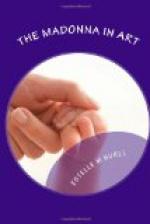Rembrandt’s domestic Madonna pictures, equally homely as to environment, are by no means scenes of hilarity, but rather of frugal contentment. Two similar works bear the title of Le Menage du Menuisier—the Carpenter’s Home. In both, the scene is the interior of a common room devoted to work and household purposes. Joseph is seen in the rear at his bench, while the central figures are the mother and child.
In the Louvre picture, the Virgin’s mother is present, caressing her grandchild, who is held at his mother’s breast. The composition at St. Petersburg (Hermitage Gallery) is simpler, and shows the Virgin contemplating her babe as he lies asleep in the cradle. Another well-known picture by Rembrandt is in the Munich Gallery, where again we have signs of the carpenter’s toil, but where the laborer has stopped for a moment to peep at the babe, who has gone off to dreamland at his mother’s breast and now sleeps sweetly in her lap. Let those who think such pictures too homely for a sacred theme compare them with the simplicity of the Gospels.
PART II.
MADONNAS CLASSED ACCORDING TO THEIR SIGNIFICANCE AS TYPES OF MOTHERHOOD.
CHAPTER VI.
THE MADONNA OF LOVE.
(THE MATER AMABILIS.)
Undoubtedly the most popular of all Madonna subjects—certainly the most easily understood—is the Mater Amabilis. The mother’s mood may be read at a glance: she is showing in one of a thousand tender ways her motherly affection for her child. She clasps him in her arms, holding him to her breast, pressing her face to his, kissing him, caressing him, or playing with him. Love is written in every line of her face; love is the key-note of the picture.
The style of composition best adapted to such a theme is manifestly the simplest. The more formal types of the enthroned and glorified Madonnas are the least suitable for the display of maternal affection, while the portrait Madonna, and the Madonna in landscape or domestic scenes, are readily conceived as the Mater Amabilis. Nevertheless, these distinctions have not by any means been rigidly regarded in art. This is manifest in some of the illustrations in Part I., as the Enthroned Madonna, by Quentin Massys, where the mother kisses her child, and Angelico’s Madonna in Glory, where she holds him to her cheek.
Gathering our examples from so many methods of composition, we are in the midst of a multitude of pictures which no man can number, and which set forth every conceivable phase of motherliness.
Let us make Raphael our starting-point. From the same master whose influence led him to the study of external nature, he learned also the study of human nature. To the interpretation of mother-love he brought all the fresh ardor of youth, and a sunny temperament which saw only joy in the face of Nature. One after another of the series of his Florentine pictures gives us a new glimpse of the loving relation between mother and child.




